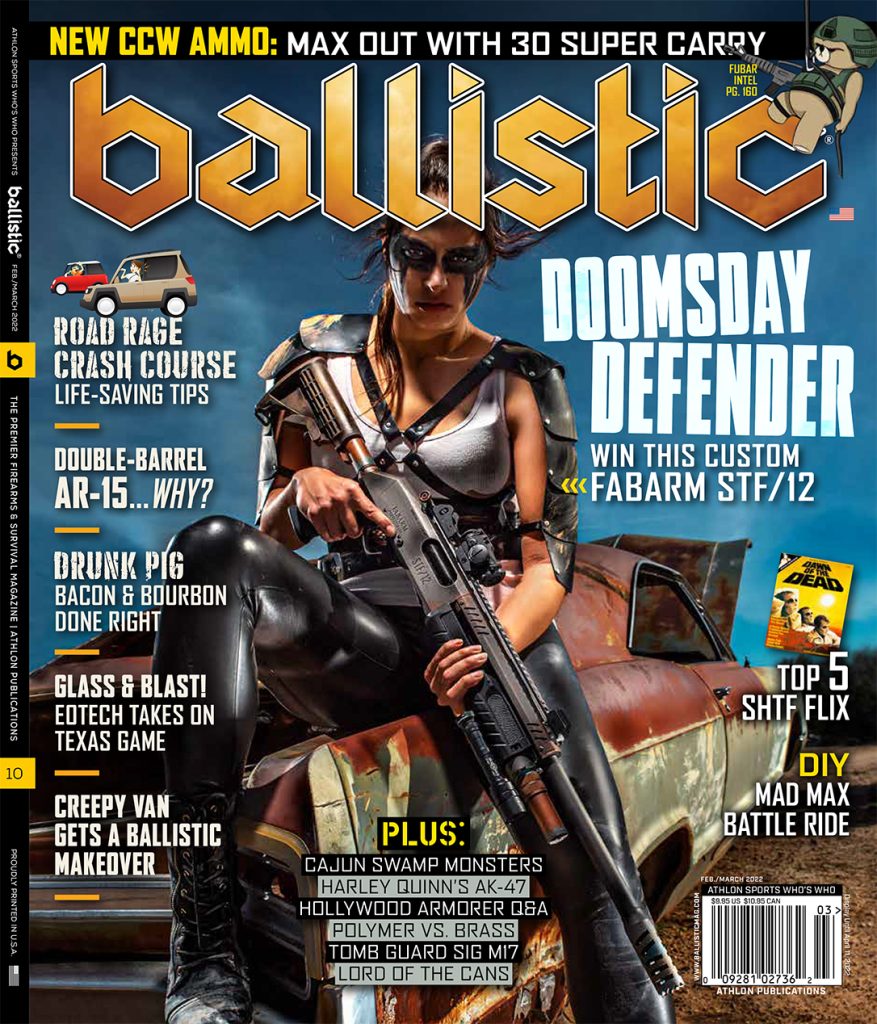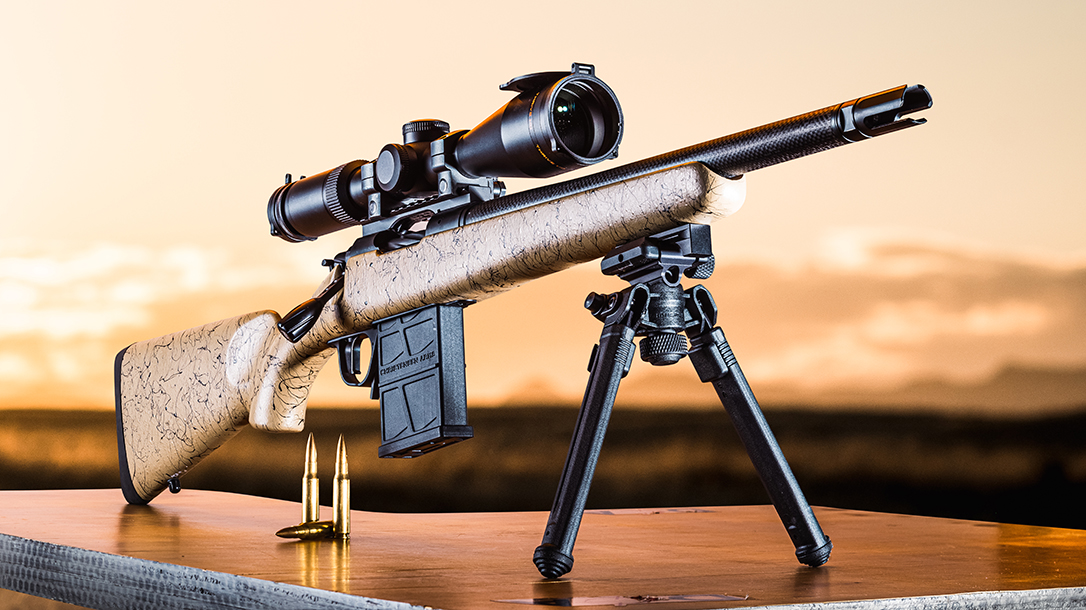The underlying component in the Scout rifle concept is versatility. This is as defined by Jeff Cooper, father of modern-day Scout rifle, in the 1980s. There are more specific criteria set forth by Col. Cooper related to the Scout rifle. These traits are passionately maintained by the Scout rifle mafia anytime the term Scout is used when referring to a rifle.
Christensen Arms Ridgeline Scout
A quick review Cooper’s scout rifle tenants is in order. “A general-purpose rifle…conveniently portable, individually operated firearm, capable of striking a single decisive blow, on a live target ….” Cooper specified overall length of 39 inches and weight of 6.6 pounds as ideal. The signature “scout” intermediate eye relief, low-powered scope mounted in front of the action sets the aesthetic tone in Cooper’s concept. The rifle also must have provision for ammunition capacity with efficient reloading offering a modicum of firepower—think stripper clip or, more recently, detachable magazine. Finally, the rifle’s chambering must be powerful enough to anchor a quarry weighing up to 1,000 pounds while still lending itself to other criteria such as capacity and size of rifle—the .308 Win has come to be accepted as the most natural cartridge.
New Standard?
Stagnant is not a word that applies to Christensen Arms. Much of this stems from the non-typical background associated with founder Dr. Roland Christensen and his endeavors in the aerospace industry. Roland’s doctorate in mechanical engineering led the way to his understanding of how best to apply carbon fiber to the benefit of firearms. This article will feature Christensen Arms take on the general-purpose bolt action as embodied by the Ridgeline Scout chambered in .308 Win.
Advertisement — Continue Reading Below
One overarching theme with Christensen Arms stemming from their carbon wrapped barrels is minimizing weapon weight. The short action Ridgeline Scout tips the scale at 5.9 pounds with its threaded 1-in-10-inch twist, 16-inch barrel generating an overall length of 37.5 inches. The desirable characteristics for a general-purpose, bolt-action rifle are cold bore zero retention, repeatable accuracy, reliability and handling. There can be no compromise in terms of consistent accuracy. The Ridgeline Scout checks all the boxes.
The Ridgeline Scout features a black-nitride coated action, optic rail, barricade stop piece on the forend, 10-round AICS drop-box magazine and a flat-shoe TriggerTech trigger, all pulled together by tan and black carbon-fiber composite Sporter-style stock.
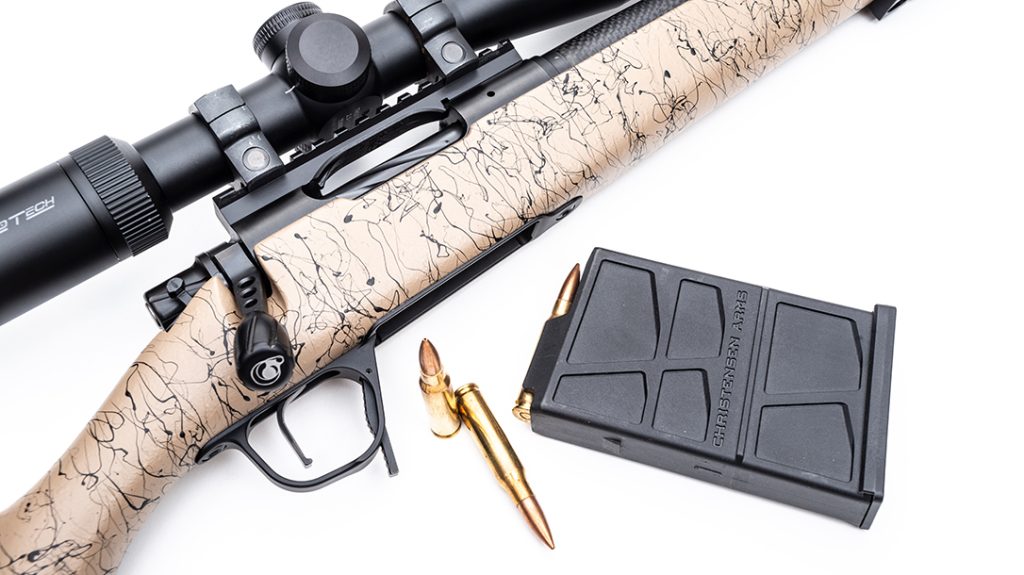
Advertisement — Continue Reading Below
Gun Details
Christensen Arms machines its actions from a solid billet of heat-treated 416T stainless steel, utilizing precision surface-ground recoil lugs. The company backs each Ridgline with a sub-MOA guarantee. Christensen machines the precision bolts in-house, before spiral fluting and Black Nitride coated for smooth operation and superior wear performance. The system employs an M16-style extractor. The ejector sits on the Scout’s bolt face. The Christensen bolt is conducive to long-range accuracy due to extremely stiff design/rigid design and high-quality control during manufacturing. The bolt is Nitride coated at 70 HRC for extreme wear protection. The Ridgeline Scout’s receiver has integrated 0 MOA Picatinny rail for stable scope mounting.
Christensen barrels are created from 416R stainless steel. Each barrel is stress relieved and hand lapped to guarantee sub-moa accuracy. Christensen’s in-house, button-rifling production utilizes aero grade processes and specifications in each barrel. Reamed and inspected to a tolerance of +/- .0001, the barrels’ muzzle is threaded and arrives with a removable three-prong flash hider. Christensen Arms’ chamber is CNC machined using minimum-diameter, match-grade reamers and optimized for accuracy and performance. The factory-installed Triggertech trigger, adjusted to 2.5-3 pounds, provides a great feature.
The carbon-fiber composite stock features dual bedding pillars constructed from Invar, a nickel/iron alloy known for its uniquely low coefficient of thermal expansion. Unlike aluminum, Invar pillars do not expand or contract with temperature changes so you will not experience variances in bedding or accuracy. In addition, Christensen spot beds the recoil lug area to ensure stability and optimal performance.
Advertisement — Continue Reading Below
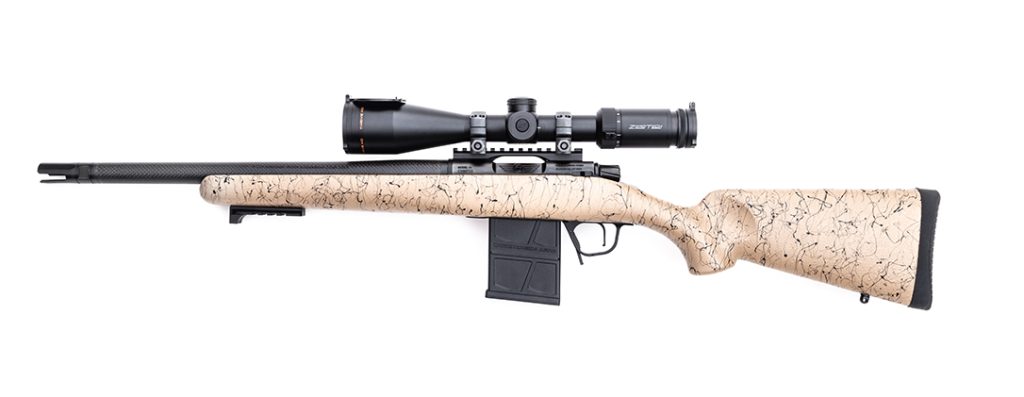
Nice New Glass
Scope selection was agonized over. I did not want to put an anchor on the top rail; yet still wanted magnification range to take advantage of the svelte accurate Ridgeline Scout. Remember multipurpose roles, stalking game while maintaining long-range punch across a clearing or field. An important part of the accuracy equation is a quality optic to go along with cartridge and rifle.
ZeroTech Optics’ Thrive HD 2.5-15x50mm with SFP PHR II illuminated reticle was mounted on the Ridgeline Scout. The Thrive HD offers a 30mm tube, 92 percent light transmission, glass etched reticle, generous eye relief and Weathershield lens coating. Lifetime warranty for any owner or any problem seals the deal. All for well under $1,000. The choice of optic may surprise in terms of company and details.
Advertisement — Continue Reading Below
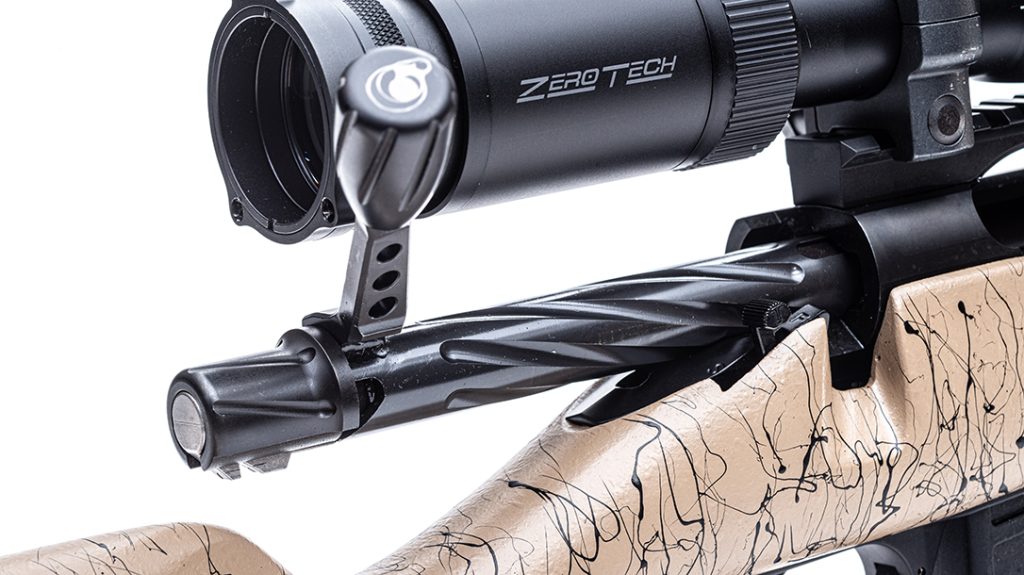
Aussie, Aussie, Aussie
ZeroTech remains relatively unknown in the U.S. market. Headquartered in Australia, U.S. operations is based outside of Nashville, Tennessee. I was turned onto them by an industry friend based out west where longer-range shots are the norm. ZeroTech is focused—pun intended—on providing hunting optics. Fifty years of experience in the rugged Australian Outback is the company’s guiding force. The optic details present a potential surprise. Why not a 1-8X or 1-10X optic? Does it have to be the 2.5-15x magnification range? Why second focal plane (SFP)?
The SFP ZeroTech illuminated PHR II reticle was a large factor in optic selection. PHR II features a floating center dot for an ultra-refined point-of-aim as well as a finer 6 o’clock reticle post, enabling even more precise elevation hold overs. Ability to illuminate center of the reticle is crucial for dawn/dusk and thick timber conditions. The aiming point presents clearly on prey. Illumination also facilitates quick reactions if game is jumped—think red dot. I am probably risking excommunication here but I prefer second focal plane reticles, especially for hunting. The ZeroTech Thrive HD’s extra magnification came with only a few ounces more weight than a 1-8x or 1-10x optic.
Advertisement — Continue Reading Below
Firing Line
I chose various .308 Win. hunting and match loads from Hornady, Black Hills Ammunition, SIG Sauer, and Winchester for testing. The specific loads were Sig Sauer’s 150-grain HT Copper, 165-grain Controlled Expansion Tip (CET) and 168-grain Match. Hornady 168-grain BTHP, Black Hills 180-grain Accubond and Winchester’s excellent 168-grain Match rounded out the fodder. This is just a small splattering of the .308 Win loads available.
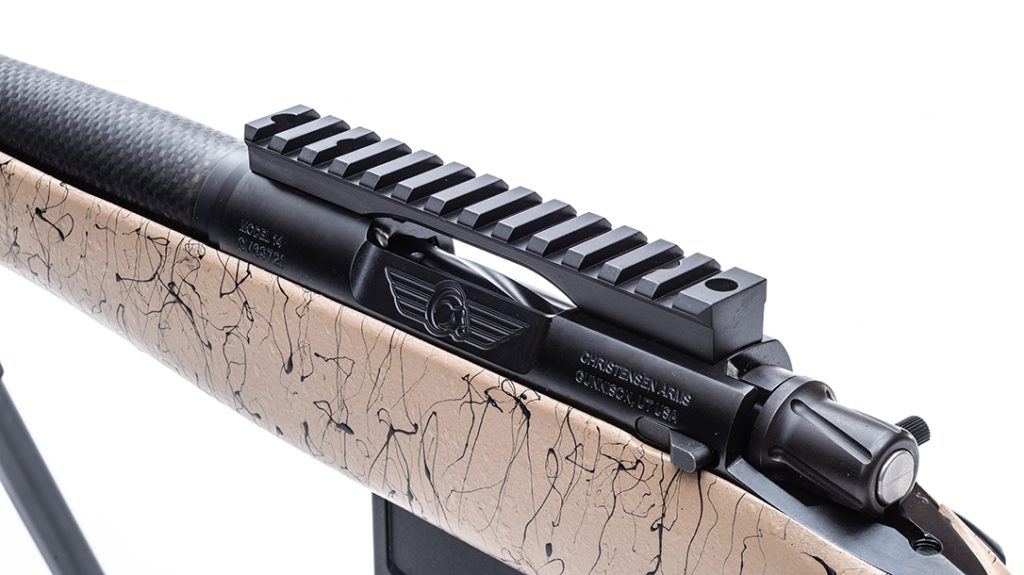
Good marksmanship in the field starts with confidence. Proven inherent accuracy as demonstrated from the bench is a good start. A rifle that shoots well off the bench offers the shooter no excuses or alibis when serious practice starts using field shooting positions or in the woods. I fired multiple groups with each load. Overall, accuracy was impressive with no five round group larger than 1.25 inches at 100 yards with most at or under the magical one-inch mark. The Sig Sauer Elite 165 grain CET took the accuracy title with a 0.38-inch group. The kind of accuracy exhibited by the Ridgeline Scout warrants a higher power scope in my opinion versus an intermediate eye relief scope. Today’s optic choices blow away 1980 scopes.
Advertisement — Continue Reading Below
Proficiency begins with realistic practice/training scenarios. Range evaluation at Echo Valley Training Center (EVTC) consisted of setting up 6-inch steel target circles from 110-330 yards and then assuming prone, sitting, kneeling or standing shooting positions. Another twist is to have a companion pick the target and shooting position for the shooter to engage as quickly as possible. While not empirically quantifiable, the Ridgeline Scout proved to “hang” well from less well-supported positions and was very manageable in getting into and out of shooting positions. I sniped clay pigeons with regularity at 475 yards from the supported prone position.
Adding A Silencer
The Ridgeline Scout’s threaded barrel readily accepted a CZ Ti Reflex suppressor. The benefits of suppressor use are hard to argue against. Cooper’s initial Scout features failed to include a threaded barrel, but he would likely appreciate today. The CZ-USA intent of maintaining short install length with their suppressors is evident by the three-inch reflex chamber that expands volume by fitting over barrels. When barrel profile demands, a standard flush mount replaces the reflex chamber. The swirled shape of the internal baffle structure exhibits in the exterior; construction welds each baffle to the next until the stack creates a unique silhouette. Not only does this eliminate extra material that would simply add weight, but it also increases surface area for heat dissipation.
I was fortunate some time ago to discover Engel Ballistic Research (EBR) as a primary source of quality sub-sonic ammunition due to the variety of calibers and loadings offered. The Ridgeline Scout combined with CZ Ti Reflex suppressor and Engel Ballistic Research sub-sonic .308 Win loads are eerily efficient out to 75-100 yards.
Advertisement — Continue Reading Below
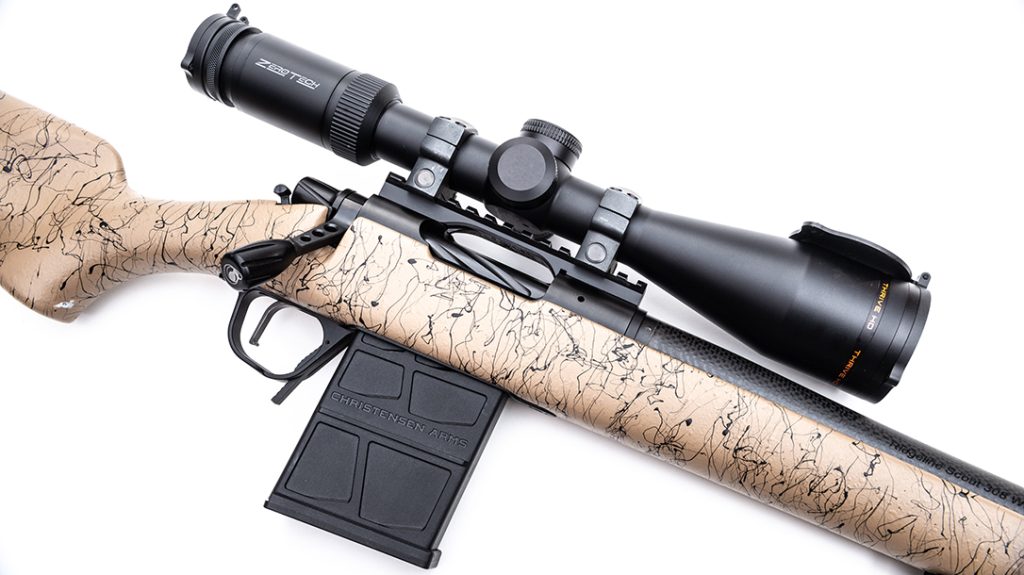
Final Thoughts
Few comments about the Ridgeline Scout—more opinion that criticism. I did not care for the barricade stop rail under the forend. This is something more for a PRS rifle than a hunting rifle. A normal section of rail that allows a sling mount and/or bipod would have been fine.
Col. Cooper’s shadow will always be present for any rifle going utilizing Scout nomenclature. As soon as I saw the model’s name, I was looking for the forward mounted rail section where intermediate optic would fit. I wonder how many phone calls and emails Christensen Arms receives over this? My article already highlights my satisfaction with normal optic position over the receiver.
Advertisement — Continue Reading Below
Lt. Col. Jeff Cooper’s shadow will always be present for any rifle utilizing Scout nomenclature. We must resist being dogmatic. Anyone using the Ridgeline Scout will consider themselves well-armed and ready to handle most situations. Jeff Cooper’s Scout rifle has a legion of devotees keeping the Scout torch burning bright and rightfully so. What is not to like about a rifle whose concept is centered on versatility and real-world application.
The Christensen Arms Ridgeline Scout .308 Win proves that hyper-velocity magnum boomers weighing 10 pounds are not the only viable option. I find it hard to believe that anyone using a Ridgeline Scout would consider themselves under-gunned or at a disadvantage. For more information, visit christiansenarms.com and zerotechoptics.com.
Christensen Arms Ridgeline Scout Features & Specs
Specifications: CHRISTENSEN ARMS RIDGELINE SCOUT
- CALIBER: .308 Win (also available .300 BLK, .223 Rem, 6.5 Creedmoor)
- BARREL: 16 inches
- OA LENGTH: 37.5 inches
- WEIGHT: 5.9 pounds (empty)
- STOCKS: Carbon fiber composite
- SIGHTS: None
- ACTION: Bolt
- FINISH: Black nitride
- CAPACITY: 10+1
- MSRP: $2,200
Christensen Arms Ridgeline Scout Performance
| Load | Velocity | Accuracy |
| Black Hills 180-grain Accubond | 2,412 | 0.75 |
| Hornady 168-grain BTHP | 2,595 | 0.88 |
| SIG Sauer 150-grain HT | 2,659 | 0.75 |
| SIG Sauer 165-grain CET | 2,566 | 0.38 |
| Winchester 168-grain Match | 2,571 | 0.50 |
This article originally appeared in the February-March 2022 issue of Ballistic Magazine. Get your copy or digital subscription today at OutdoorGroupStore.com.
